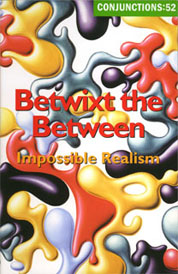
- On sale now!
Last week, Powell’s devoted daily guest blogs to Conjunctions 52: Betwixt the Between, which features among a host of excellent tales my translation of Georges-Olivier Châteaureynaud’s short story “La Tête,†which uses a horror trope (the severed head) taken from historical fact (Dr. Beaurieux’s experiments with the guillotine) to explore themes of innocence, experience, and euthanasia.
In her post, Elizabeth Hand notes
“…the original impulse behind gothic art and literature: to evoke awe and terror at the same moment. In 21st century pop culture, that balance has tipped in favor of terror, usually deployed as gruesome cinematic violence. But great literature of the fantastic re-calibrates and celebrates that balance…â€
Her words recall a significant debate in Francophone literature, which after the Second World War saw an efflorescence in the genre of the fantastique largely forgotten today. During “the quarrel of the fantastique,†critic Roger Caillois (perhaps best known if at all in the States for “discovering†Borges) advanced in 1958 the claim that the genre’s sole function was to provoke fear; that, indeed, the genre was a “game†or “play†of fear, an exercise in pure fiction whose manipulations were aimed at eliciting a single emotion. (It should be noted that Caillois’ background and interests included anthropology and sociology, specifically the study of play.)
Writer Marcel Schneider, himself a distinguished historian and scholar, voiced strident objection. Arrayed around these antagonists were such Belgian writers of the genre as Jean Ray and Marcel Thiry, with French critic Jacques Brenner as arbiter. Schneider believed the genre primarily served “to reveal what lies beyond appearances, reason, the known world,†and that this revelation could be effected by “terror or the sweetest pleasure.â€
“Purely poetic feeling is as good as a conductor as horror,†he wrote; for him the fantastique involved a supernatural phenomenon whose only explanation lay in its “poetic charge.â€
That this very debate seems antiquated may be due to the fact that terror has indeed won out, and that the genre itself has become neglected. In an interview from 2000, G.-O. Châteaureynaud expresses his concern that horror has a single theme: evil (and its corollaries, fear and guilt). “In the face of pure terror,†he notes, “there is no culture, humor, or poetry.†For him, the fantastique—its expressive variety and possibility—has been impoverished by the ascendance of horror and gore. In their belief that the fantastique is flexible and capacious enough to examine every aspect of humanity and society, Châteaureynaud and Schneider are united.
Of interest to note, with regard to the intentionality of Hand’s reference, is the fact that her contribution to the issue, “Hungerford Bridge,†is a perfect example of a fantastique story in its classical form, in which an impossible and inexplicable phenomenon, usually the crux of the story, briefly visits or is visited upon the protagonist, with its otherworldly brilliance almost incidentally shedding some light on his or her character. As Caillois would say, the fantastique “manifests itself as scandal, rift, or tear, an uncanny, almost unbearable irruption into the real.†For realists, this event is the elephant in the room, and must at least reduced to metaphor, if not psychological explanation. But isn’t one of our primal disappointments with a story that it all turns out to be a dream?
Leave a Reply